Ragged Mountain Ski Patrol gets a jump on the season with annual refresher training
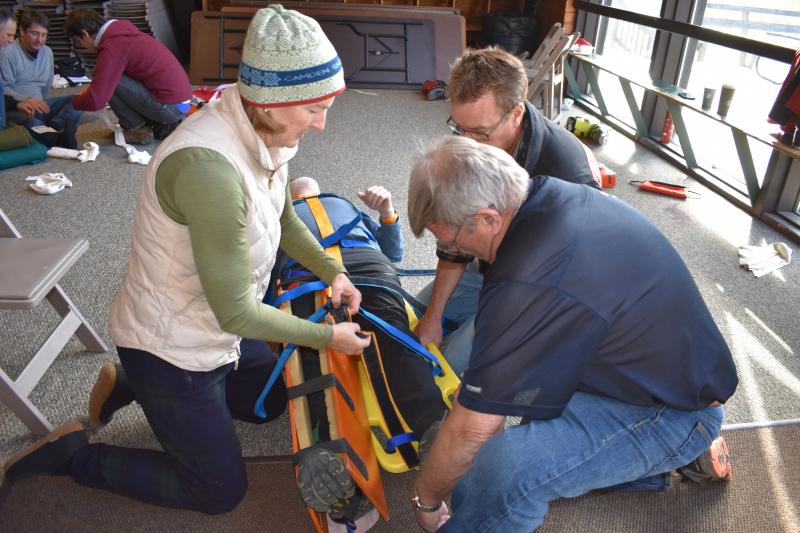 Volunteer ski patrollers Deb Moskowitz, Dan Beardsley and Avery Brott practice working together to prepare a patient with a leg injury for transport down a ski trail. (Photo courtesy Sarah Thompson)
Volunteer ski patrollers Deb Moskowitz, Dan Beardsley and Avery Brott practice working together to prepare a patient with a leg injury for transport down a ski trail. (Photo courtesy Sarah Thompson)
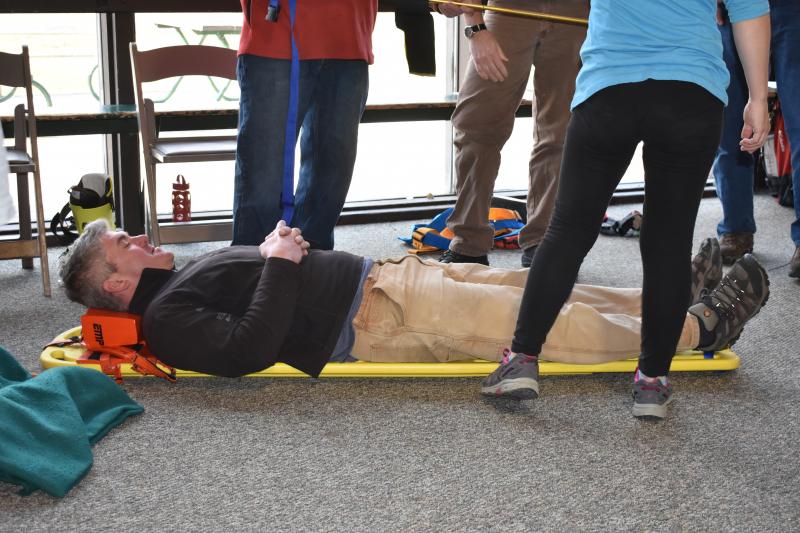 (Photo courtesy Sarah Thompson)
(Photo courtesy Sarah Thompson)
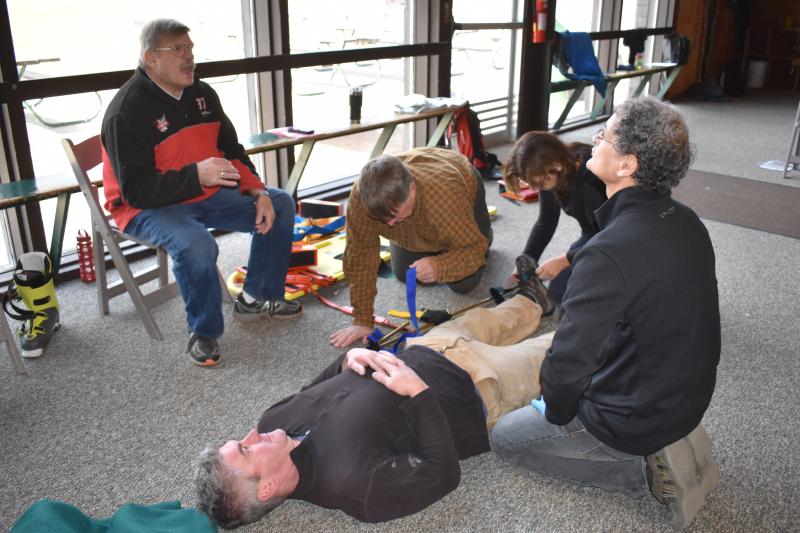 (Photo courtesy Sarah Thompson)
(Photo courtesy Sarah Thompson)
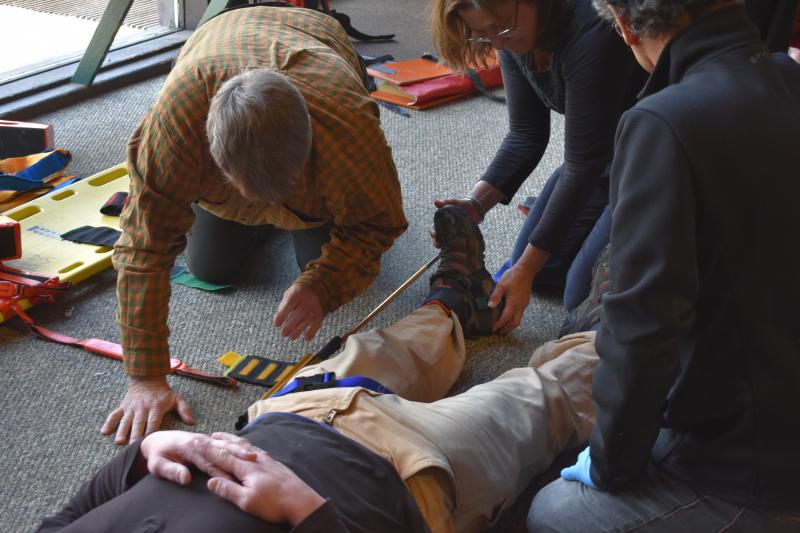 (Photo courtesy Sarah Thompson)
(Photo courtesy Sarah Thompson)
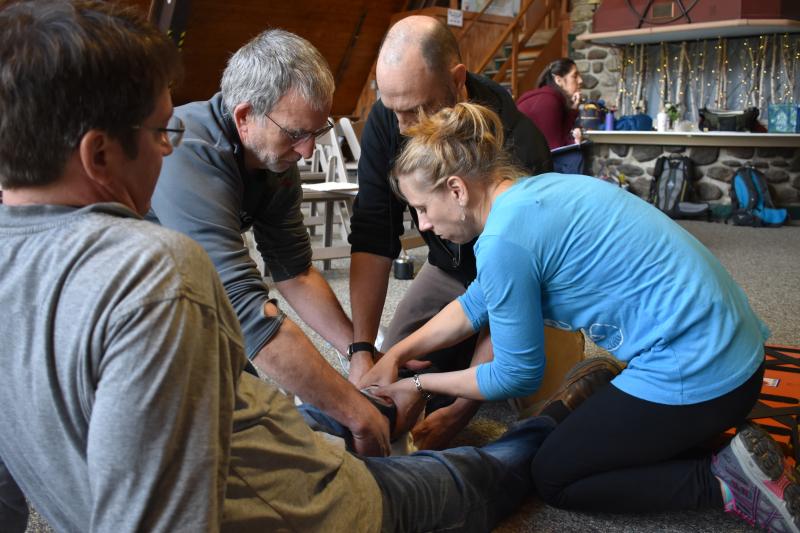 Ragged Mountain Ski Patrol Director Duncan Matlack plays victim with a leg injury while patrollers Ken von Felten, Kevin Davis and Danielle Beardsley practice knee injury treatment. (Photo courtesy Sarah Thompson)
Ragged Mountain Ski Patrol Director Duncan Matlack plays victim with a leg injury while patrollers Ken von Felten, Kevin Davis and Danielle Beardsley practice knee injury treatment. (Photo courtesy Sarah Thompson)
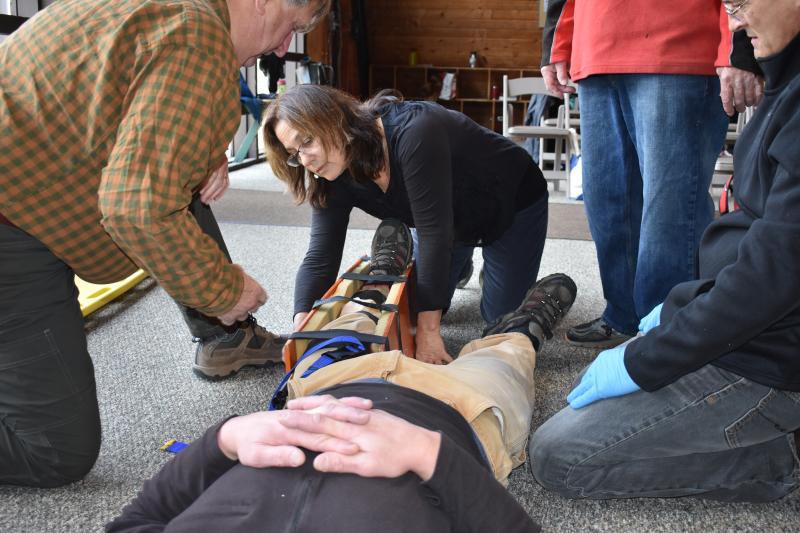 Patroller Lynda Clancy straps the splint onto the injured leg. (Photo courtesy Sarah Thompson)
Patroller Lynda Clancy straps the splint onto the injured leg. (Photo courtesy Sarah Thompson)
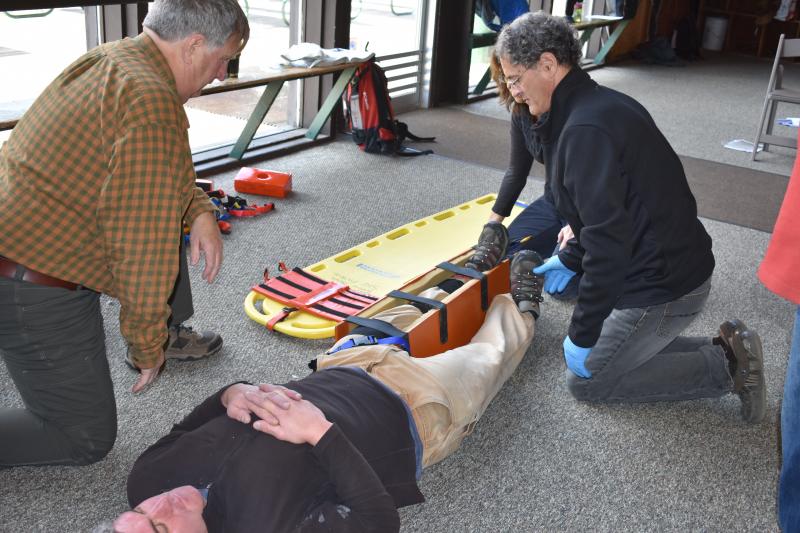 Patroller Steve Hedsell, right, secures a splint to an injured leg. (Photo courtesy Sarah Thompson)
Patroller Steve Hedsell, right, secures a splint to an injured leg. (Photo courtesy Sarah Thompson)
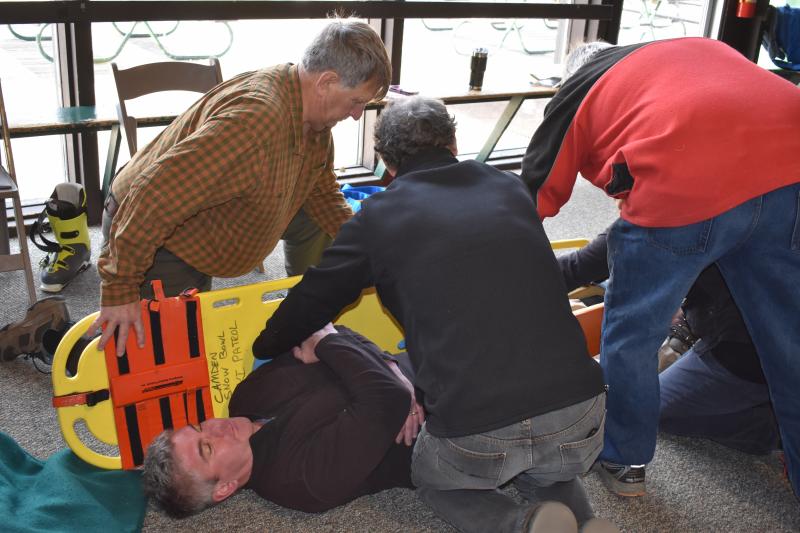 (Photo courtesy Sarah Thompson)
(Photo courtesy Sarah Thompson)
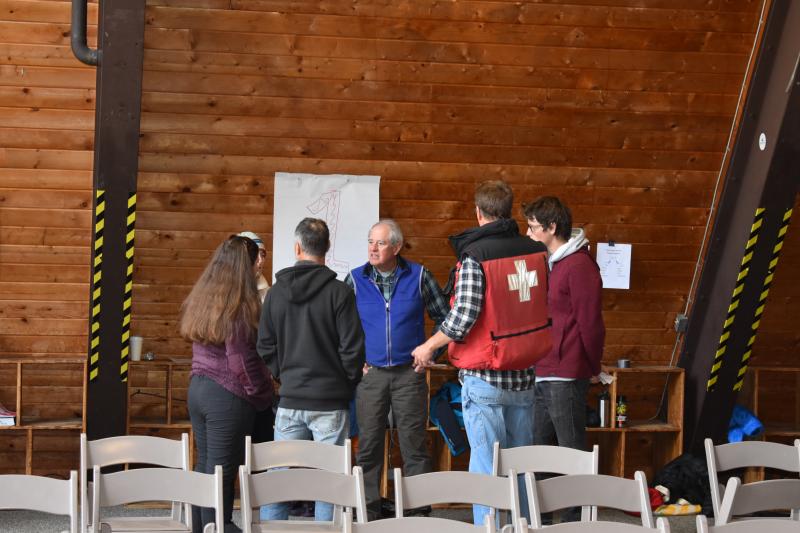 Patroller Galen Todd briefs other patrollers on scene size up, patient assessment and procedures. (Photo courtesy Sarah Thompson)
Patroller Galen Todd briefs other patrollers on scene size up, patient assessment and procedures. (Photo courtesy Sarah Thompson)
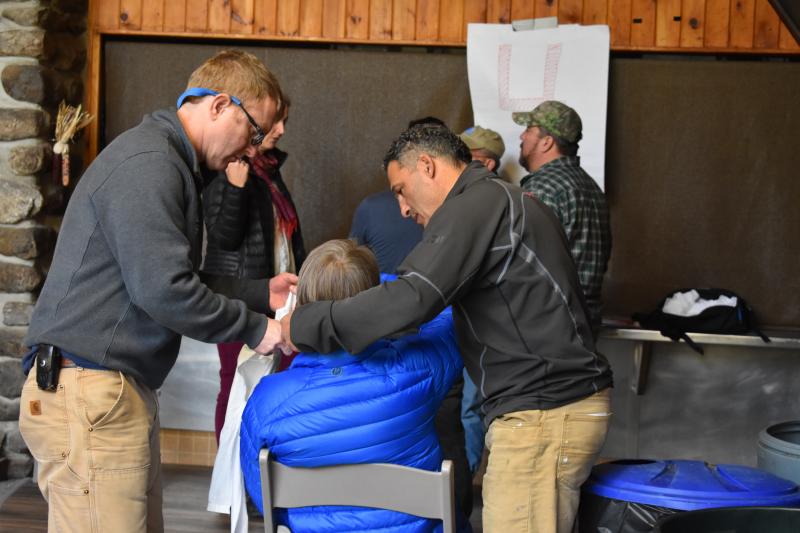 Patrollers Doug Woodbury and Tony Fitch tend to an eye injury that involves an eyeball punctured by a stick. (Photo courtesy Sarah Thompson)
Patrollers Doug Woodbury and Tony Fitch tend to an eye injury that involves an eyeball punctured by a stick. (Photo courtesy Sarah Thompson)
 Patrollers Bob Winslow and Stephanie Martin cope with eye injuries. (Photo courtesy Sarah Thompson)
Patrollers Bob Winslow and Stephanie Martin cope with eye injuries. (Photo courtesy Sarah Thompson)
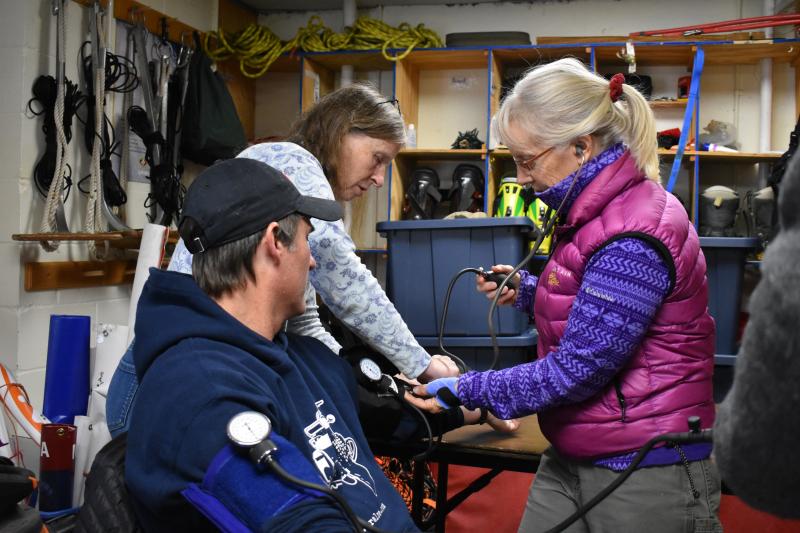 Patrollers Sandie Sabaka and Jada Beardsley checks vitals on patroller Alex Cohn. (Photo courtesy Sarah Thompson)
Patrollers Sandie Sabaka and Jada Beardsley checks vitals on patroller Alex Cohn. (Photo courtesy Sarah Thompson)
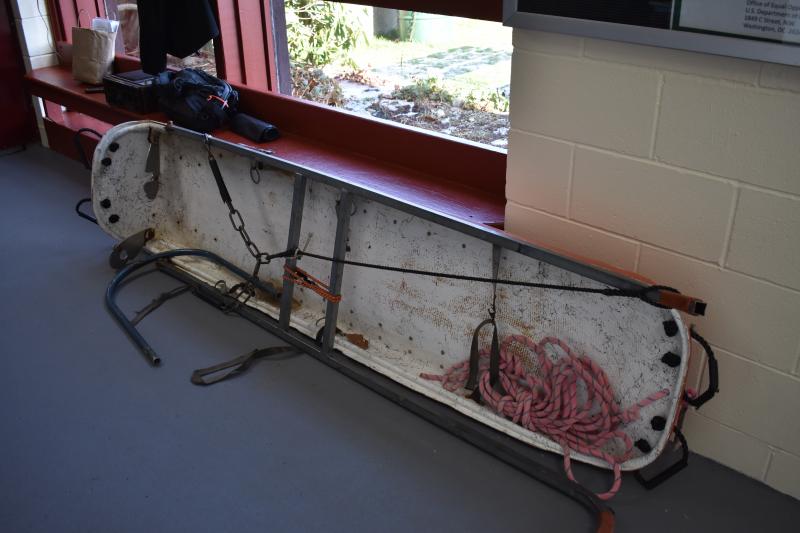 A toboggan stands at the ready. (Photo courtesy Sarah Thompson)
A toboggan stands at the ready. (Photo courtesy Sarah Thompson)
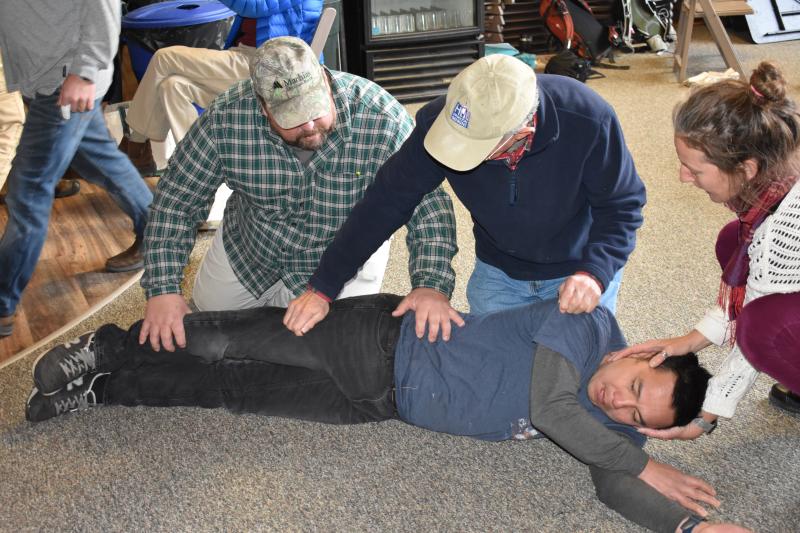 Jams and pretzels. Moving a patient without moving a suddenly misaligned joint. Patrollers Jeff Jones, Bob Winslow and Stephanie Martin work on fellow patroller victim Chuck Nguyen (Photo courtesy Sarah Thompson)
Jams and pretzels. Moving a patient without moving a suddenly misaligned joint. Patrollers Jeff Jones, Bob Winslow and Stephanie Martin work on fellow patroller victim Chuck Nguyen (Photo courtesy Sarah Thompson)
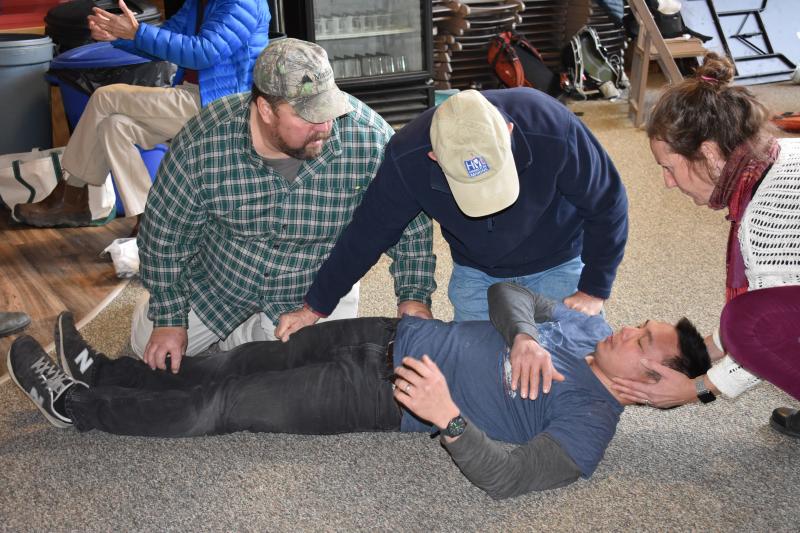 .... And onto his back. (Photo courtesy Sarah Thompson)
.... And onto his back. (Photo courtesy Sarah Thompson)
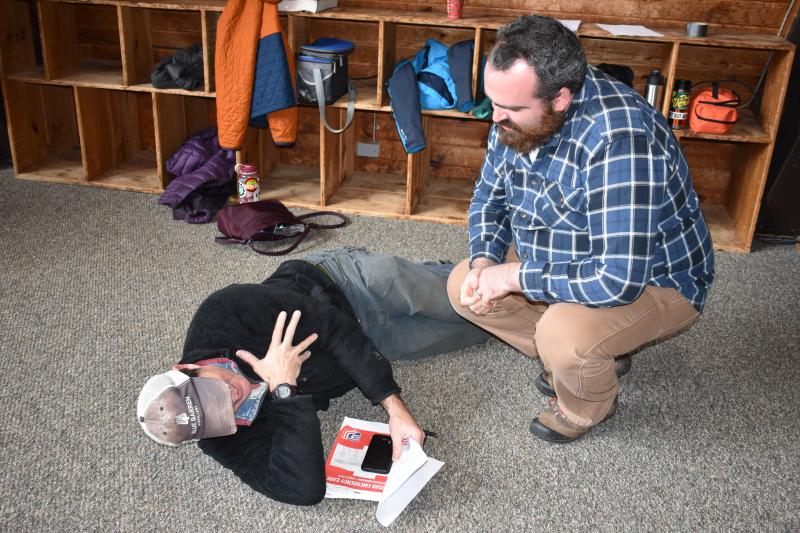 Patroller Morgan Laidlaw, age 7 in this scenario, fell on the trail. He cries and tells the patroller that his leg hurts. (Photo courtesy Sarah Thompson)
Patroller Morgan Laidlaw, age 7 in this scenario, fell on the trail. He cries and tells the patroller that his leg hurts. (Photo courtesy Sarah Thompson)
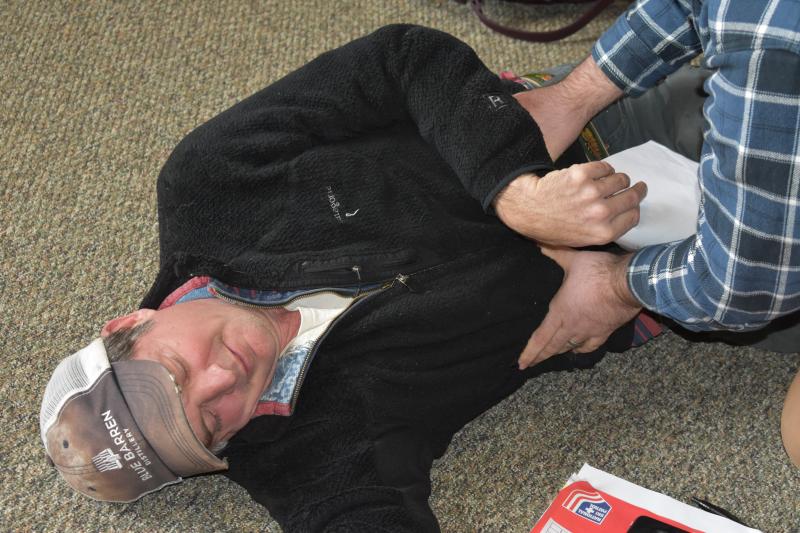 Do you hurt anywhere else? How about here? (Photo courtesy Sarah Thompson)
Do you hurt anywhere else? How about here? (Photo courtesy Sarah Thompson)
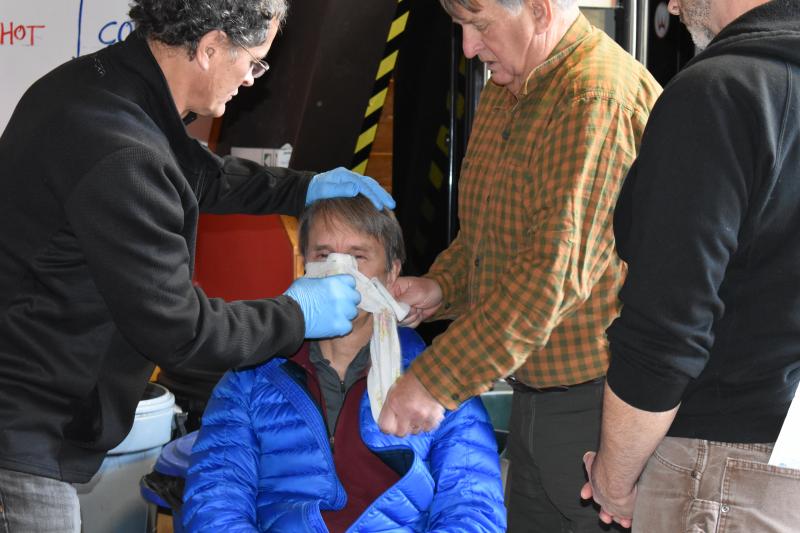 Superficial gash to patroller Brian Robinson’s nose. (Photo courtesy Sarah Thompson)
Superficial gash to patroller Brian Robinson’s nose. (Photo courtesy Sarah Thompson)
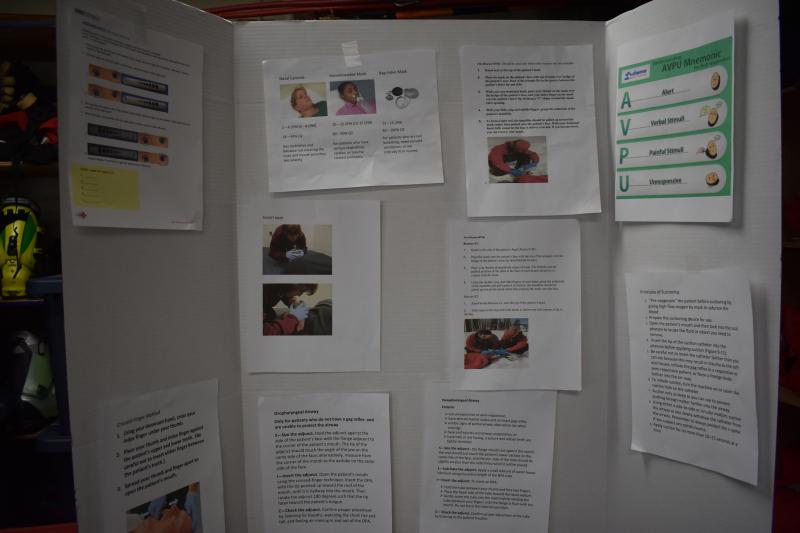 (Photo courtesy Sarah Thompson)
(Photo courtesy Sarah Thompson)
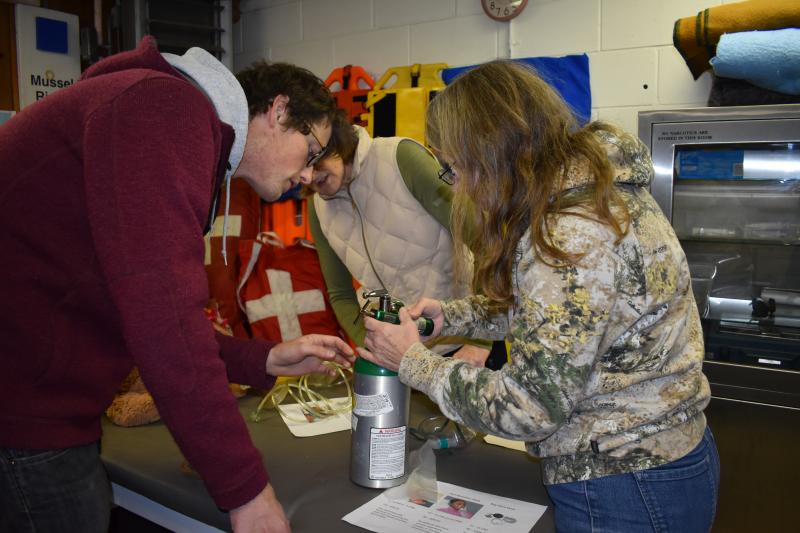 Patrollers Dominic Dill, Deb Moskowitz and Jada Beardsley get the tank ready to administer oxygen. (Photo courtesy Sarah Thompson)
Patrollers Dominic Dill, Deb Moskowitz and Jada Beardsley get the tank ready to administer oxygen. (Photo courtesy Sarah Thompson)
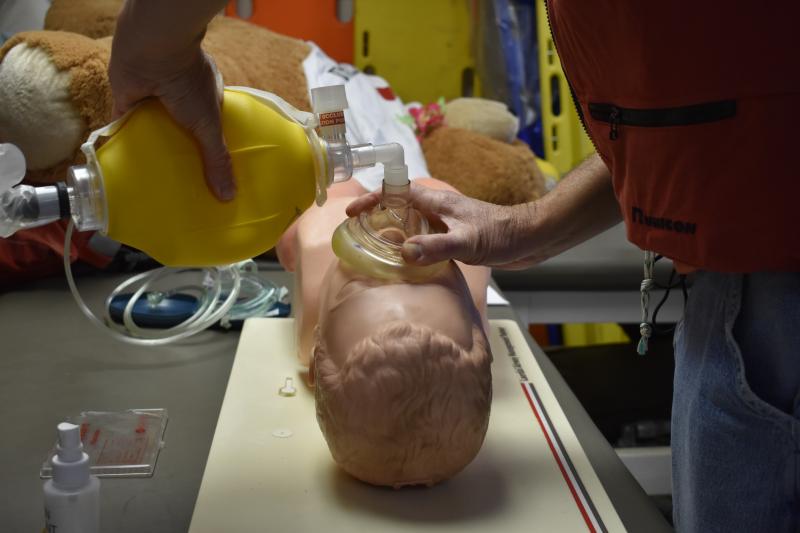 (Photo courtesy Sarah Thompson)
(Photo courtesy Sarah Thompson)
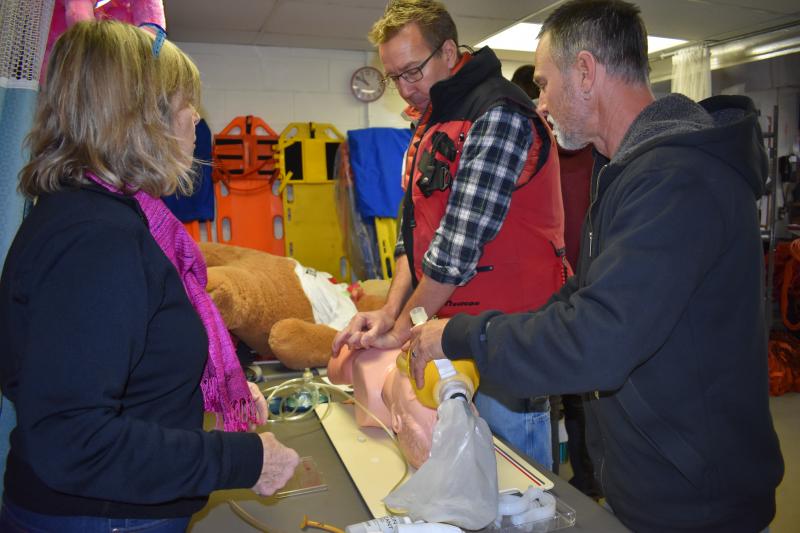 Patrollers Avery Brott, Rod Norberg and Ann Pietroski practice CPR on a victim. (Photo courtesy Sarah Thompson)
Patrollers Avery Brott, Rod Norberg and Ann Pietroski practice CPR on a victim. (Photo courtesy Sarah Thompson)
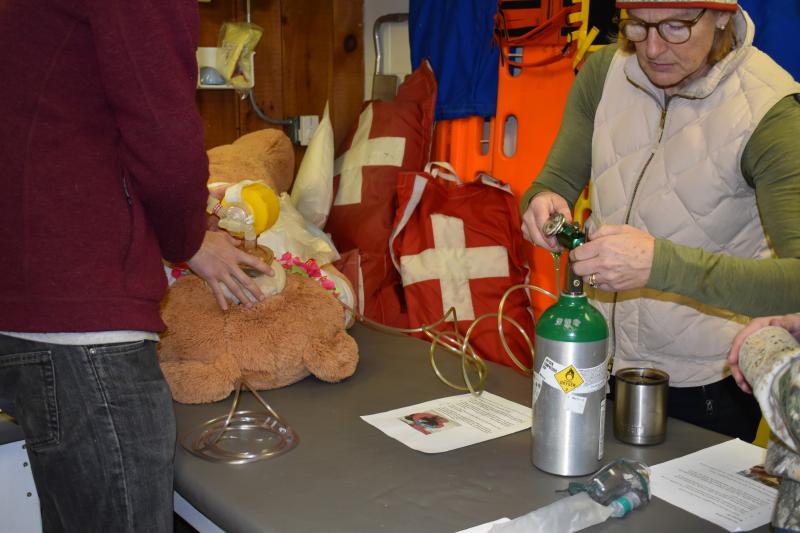 (Photo courtesy Sarah Thompson)
(Photo courtesy Sarah Thompson)
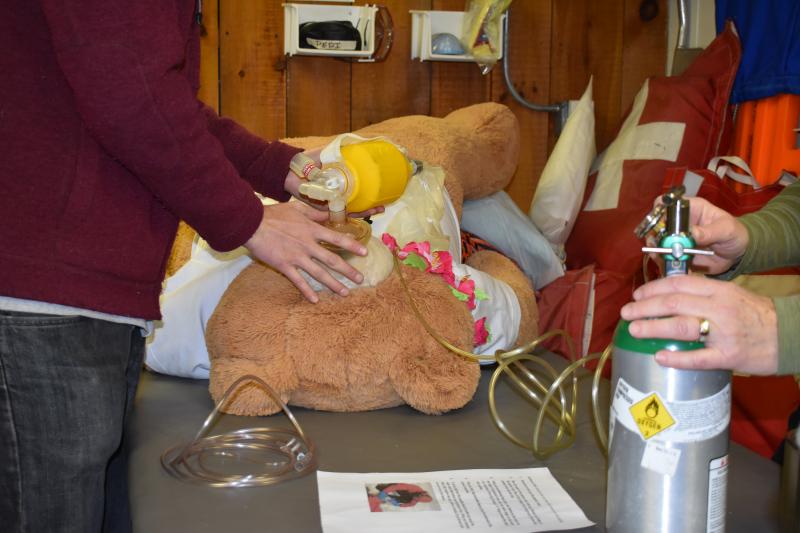 (Photo courtesy Sarah Thompson)
(Photo courtesy Sarah Thompson)
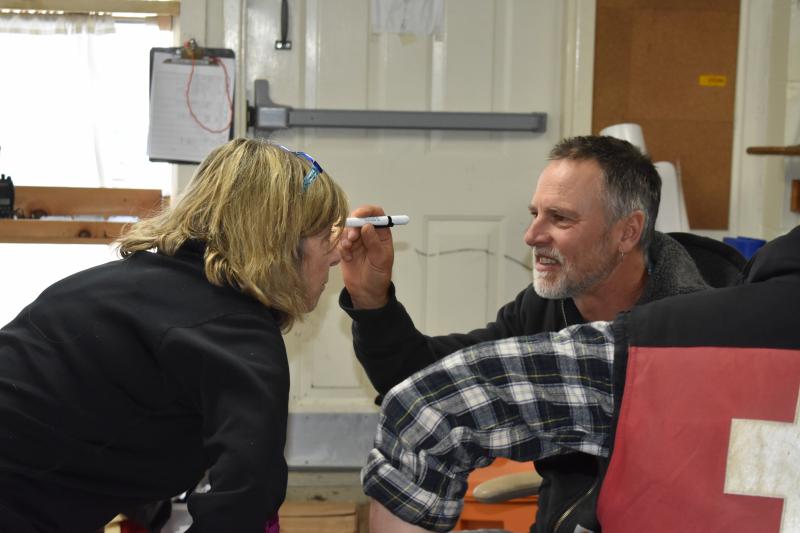 Patroller Rod Norberg uses a pen light to determine pupil dilation. (Photo courtesy Sarah Thompson)
Patroller Rod Norberg uses a pen light to determine pupil dilation. (Photo courtesy Sarah Thompson)
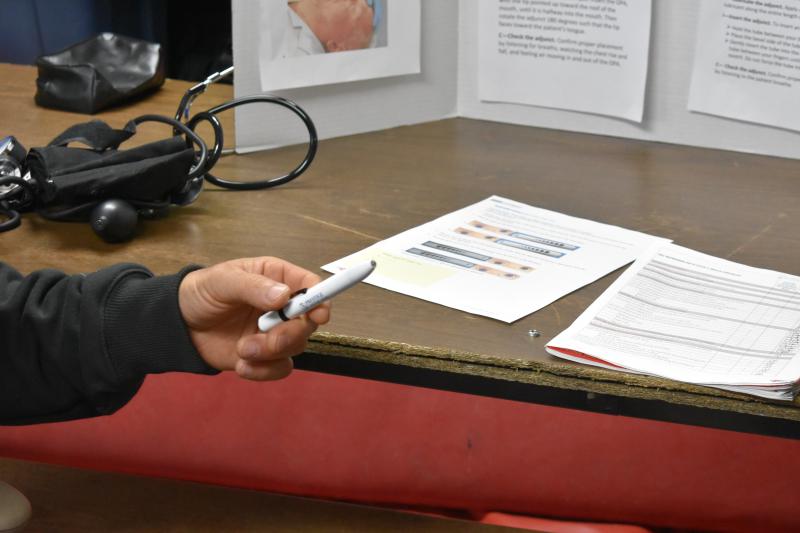 (Photo courtesy Sarah Thompson)
(Photo courtesy Sarah Thompson)
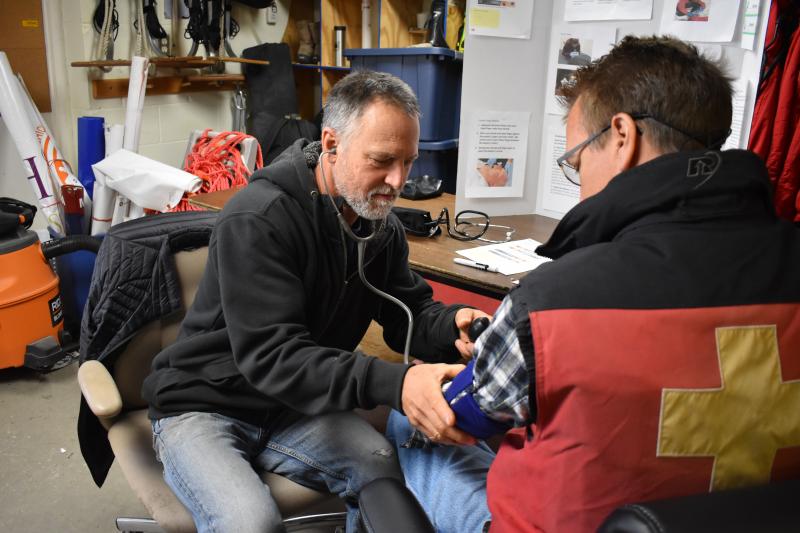 (Photo courtesy Sarah Thompson)
(Photo courtesy Sarah Thompson)
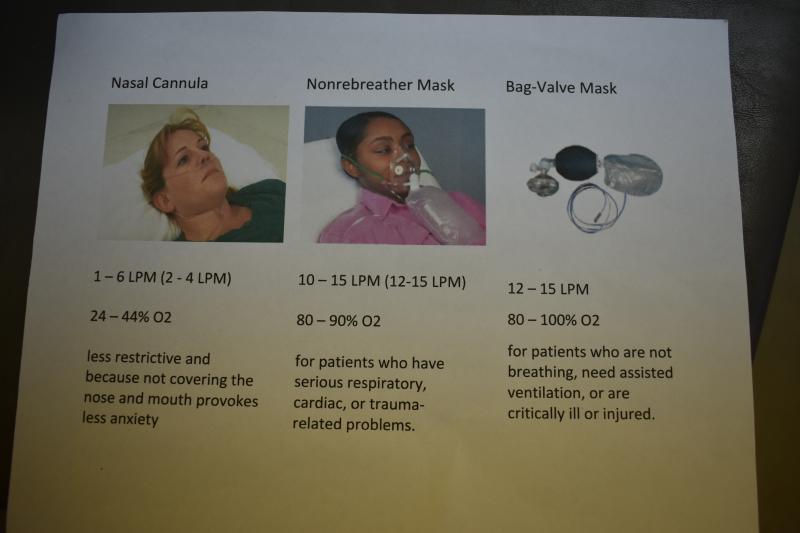 (Photo courtesy Sarah Thompson)
(Photo courtesy Sarah Thompson)
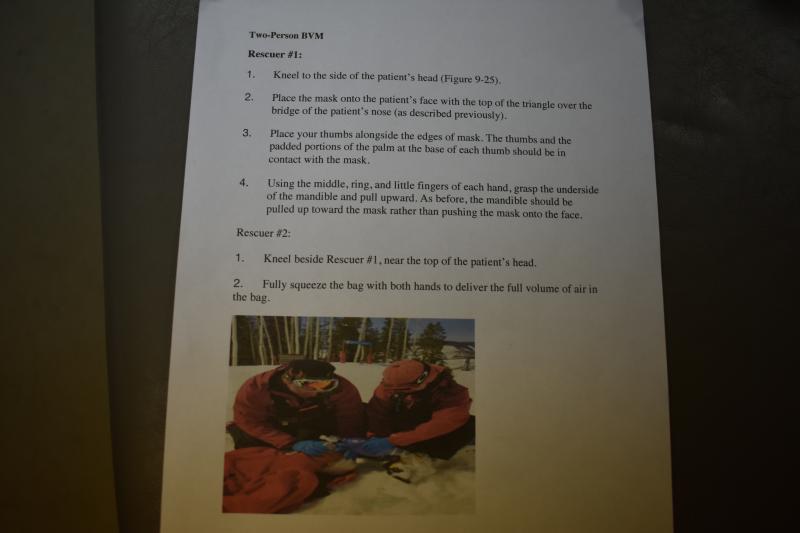 (Photo courtesy Sarah Thompson)
(Photo courtesy Sarah Thompson)
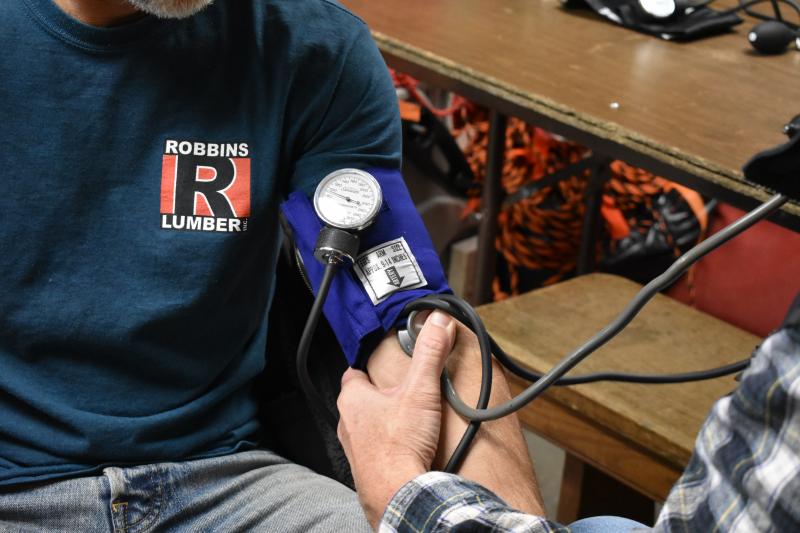 (Photo courtesy Sarah Thompson)
(Photo courtesy Sarah Thompson)
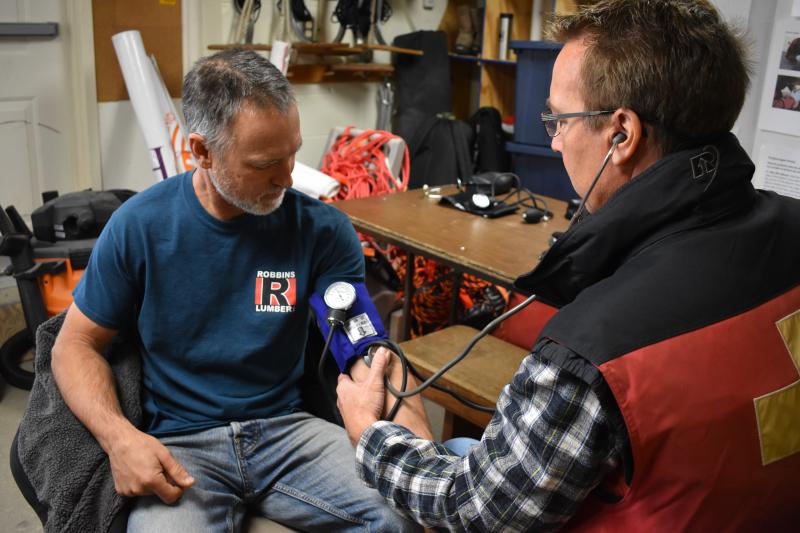 (Photo courtesy Sarah Thompson)
(Photo courtesy Sarah Thompson)
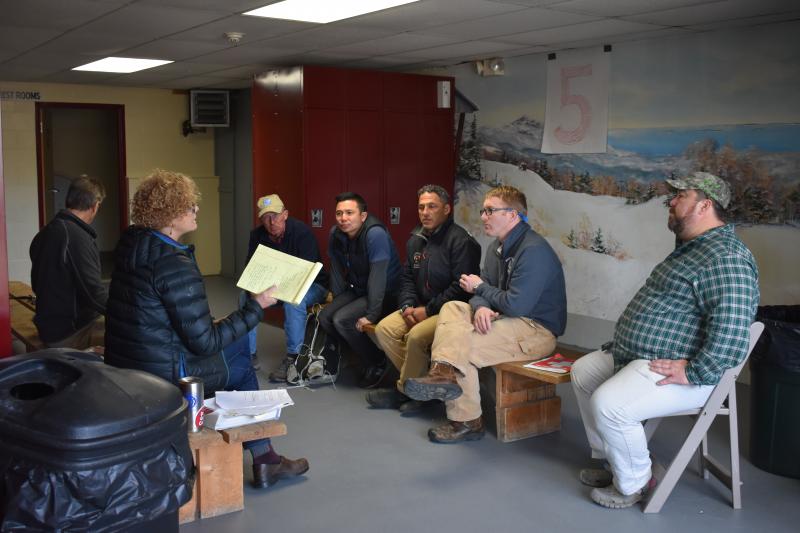 What to do if there is a gaping wound, exposing the lung. Patrollers Cathie Dorr, Michael Morse, Bob Winslow, Chuck Nguyen, Tony Fitch, Doug Woodbury and Jeff Jones talk it over.... (Photo courtesy Sarah Thompson)
What to do if there is a gaping wound, exposing the lung. Patrollers Cathie Dorr, Michael Morse, Bob Winslow, Chuck Nguyen, Tony Fitch, Doug Woodbury and Jeff Jones talk it over.... (Photo courtesy Sarah Thompson)
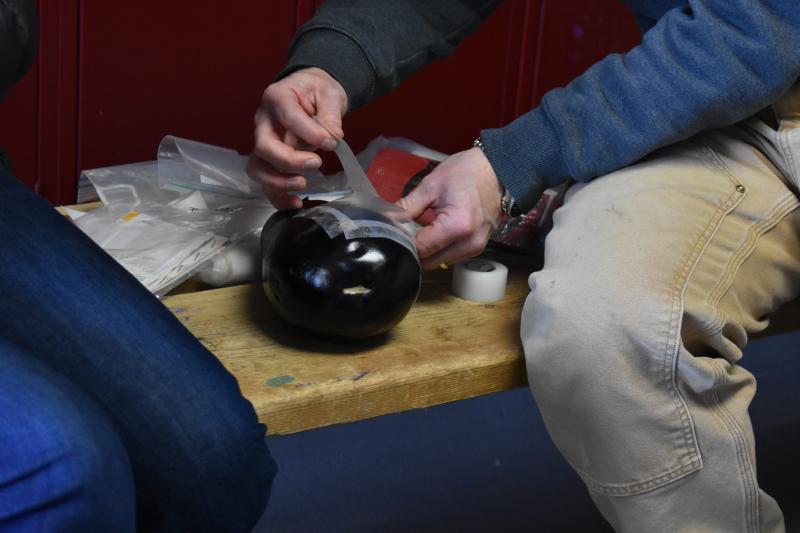 .... and practice bandaging the body around a possible lung drainage tube (in this case, an eggplant). (Photo courtesy Sarah Thompson)
.... and practice bandaging the body around a possible lung drainage tube (in this case, an eggplant). (Photo courtesy Sarah Thompson)
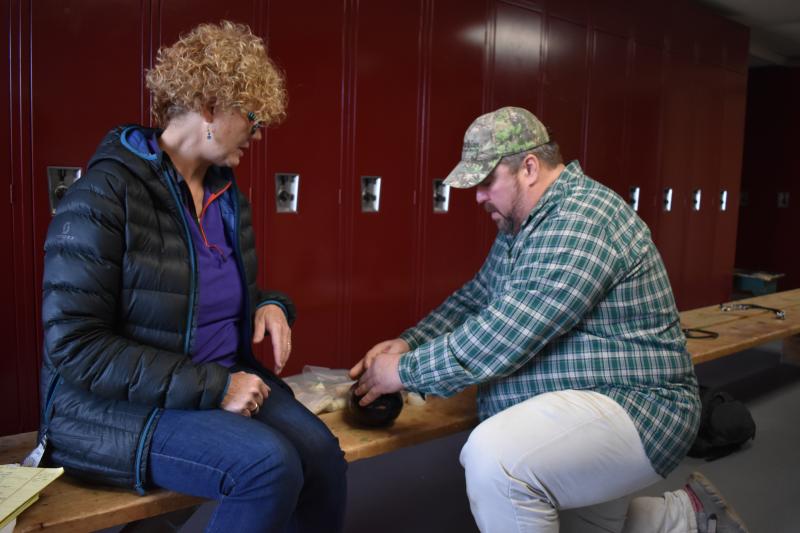 Patrollers Cathie Dorr and Jeff Jones seal up (on three sides) a gaping chest wound. (Photo courtesy Sarah Thompson)
Patrollers Cathie Dorr and Jeff Jones seal up (on three sides) a gaping chest wound. (Photo courtesy Sarah Thompson)
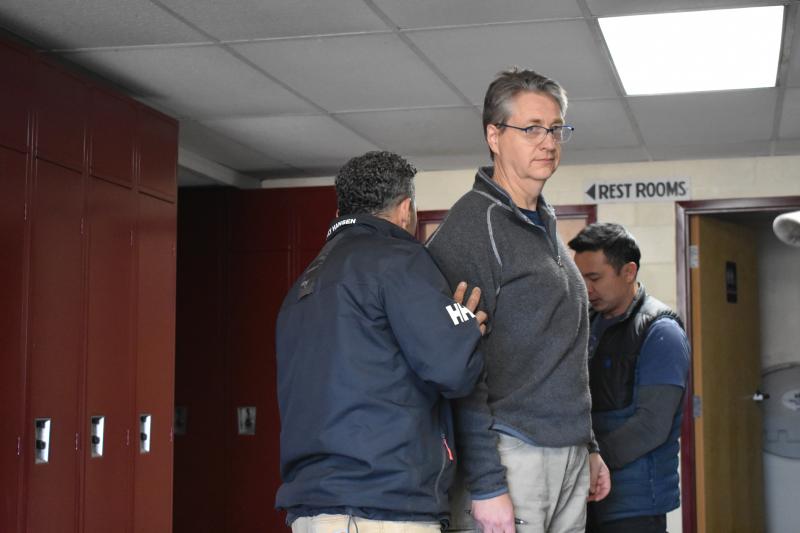 What do wheezy lungs sound like? Patrollers Tony Fitch and Chuck Nguyen practice on Michael Morse. (Photo courtesy Sarah Thompson)
What do wheezy lungs sound like? Patrollers Tony Fitch and Chuck Nguyen practice on Michael Morse. (Photo courtesy Sarah Thompson)
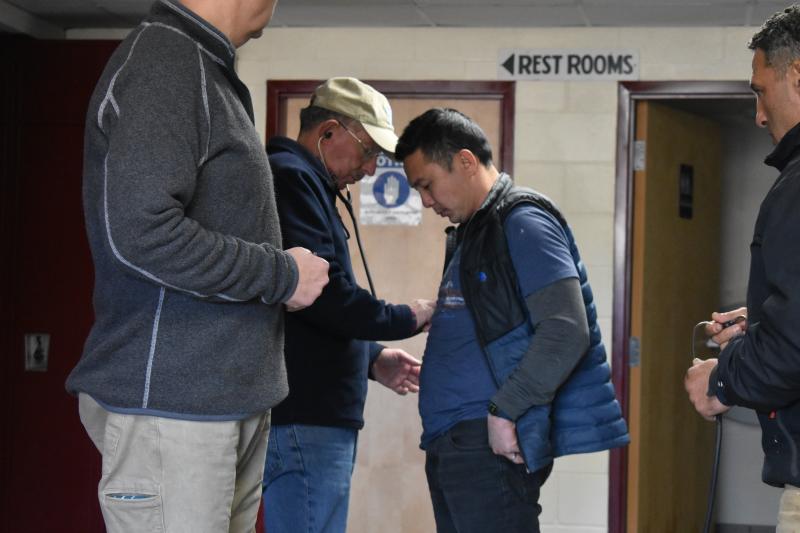 (Photo courtesy Sarah Thompson)
(Photo courtesy Sarah Thompson)
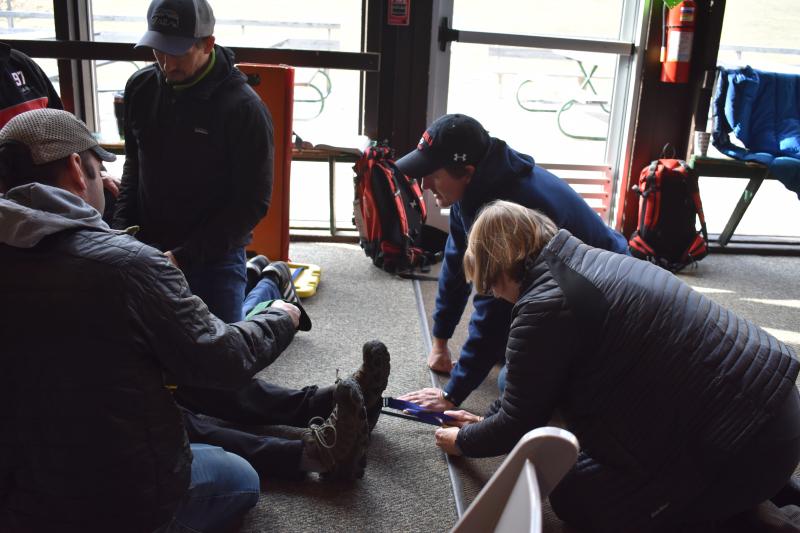 Patrollers Sarah Ruef-Lindquist and Alex Cohn practice measuring a splint for a broken femur. (Photo courtesy Sarah Thompson)
Patrollers Sarah Ruef-Lindquist and Alex Cohn practice measuring a splint for a broken femur. (Photo courtesy Sarah Thompson)
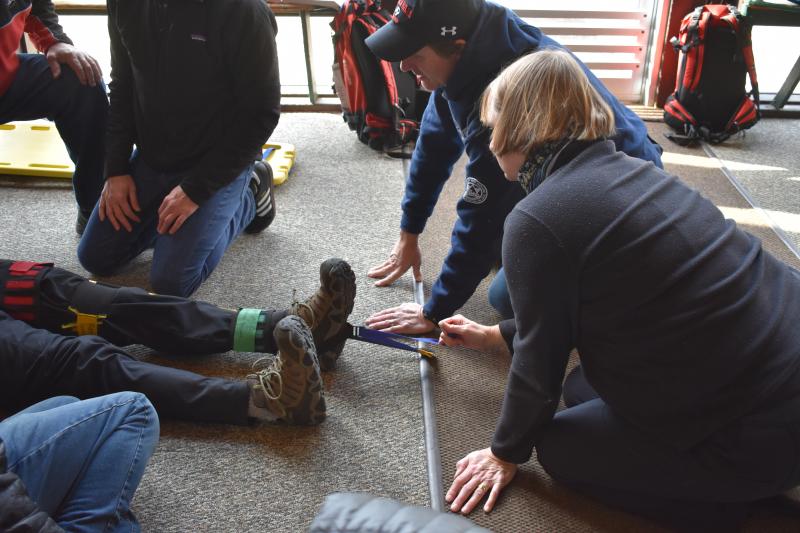 Patrollers Sarah Ruef-Lindquist and Alex Cohn practice measuring a splint for a broken femur. (Photo courtesy Sarah Thompson)
Patrollers Sarah Ruef-Lindquist and Alex Cohn practice measuring a splint for a broken femur. (Photo courtesy Sarah Thompson)
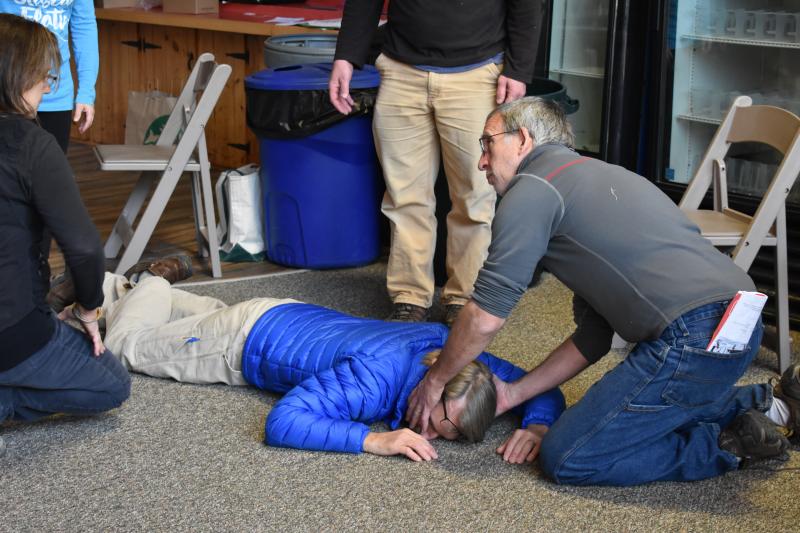 Patrollers Lynda Clancy, Ken von Felten, Danielle Beardsley get patroller victim Brian Robinson out of his jams and pretzel position... (Photo courtesy Sarah Thompson)
Patrollers Lynda Clancy, Ken von Felten, Danielle Beardsley get patroller victim Brian Robinson out of his jams and pretzel position... (Photo courtesy Sarah Thompson)
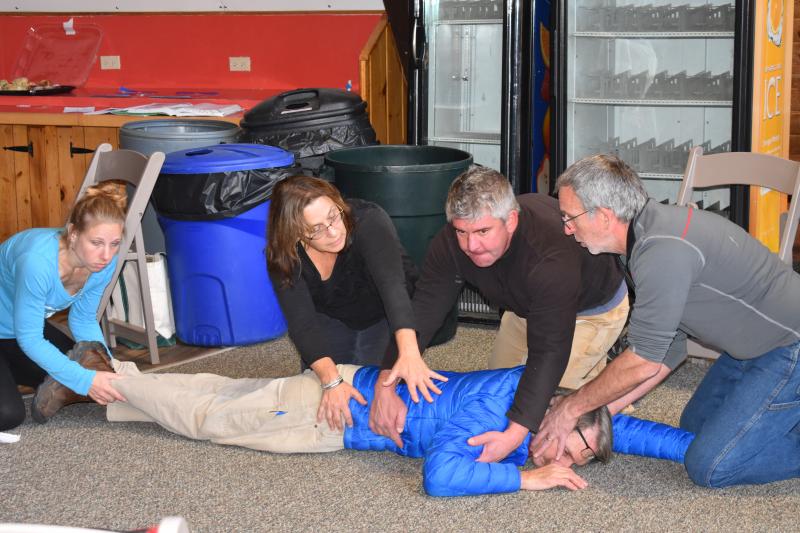 and roll him to a back board. (Photo courtesy Sarah Thompson)
and roll him to a back board. (Photo courtesy Sarah Thompson)
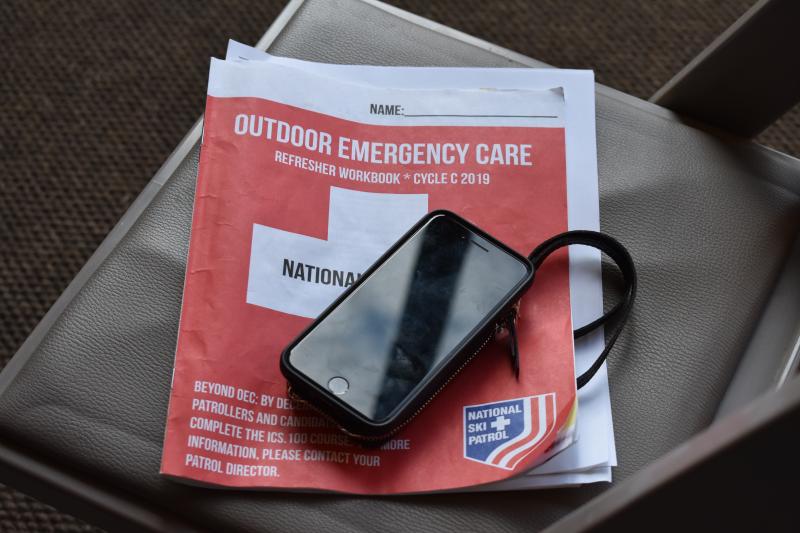 Refresher workbook is a lot lighter than the initial course book. (Photo courtesy Sarah Thompson)
Refresher workbook is a lot lighter than the initial course book. (Photo courtesy Sarah Thompson)
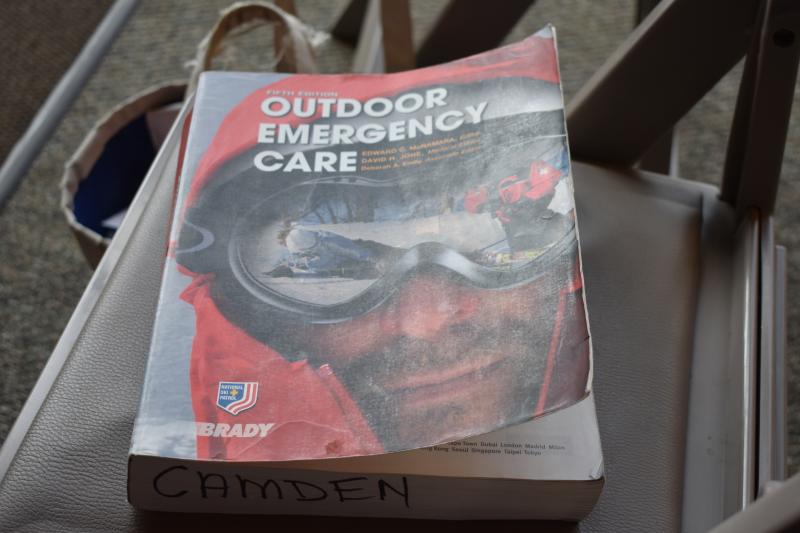 The initial course book. (Photo courtesy Sarah Thompson)
The initial course book. (Photo courtesy Sarah Thompson)
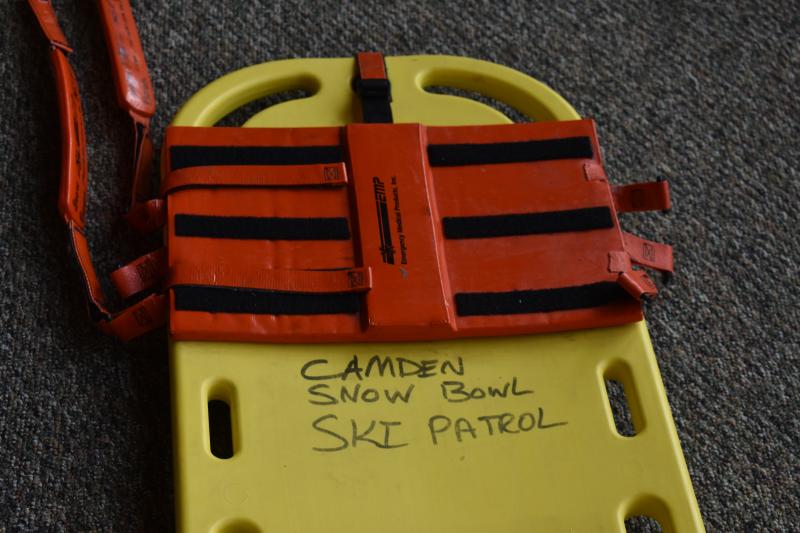 (Photo courtesy Sarah Thompson)
(Photo courtesy Sarah Thompson)
 (Photo courtesy Sarah Thompson)
(Photo courtesy Sarah Thompson)
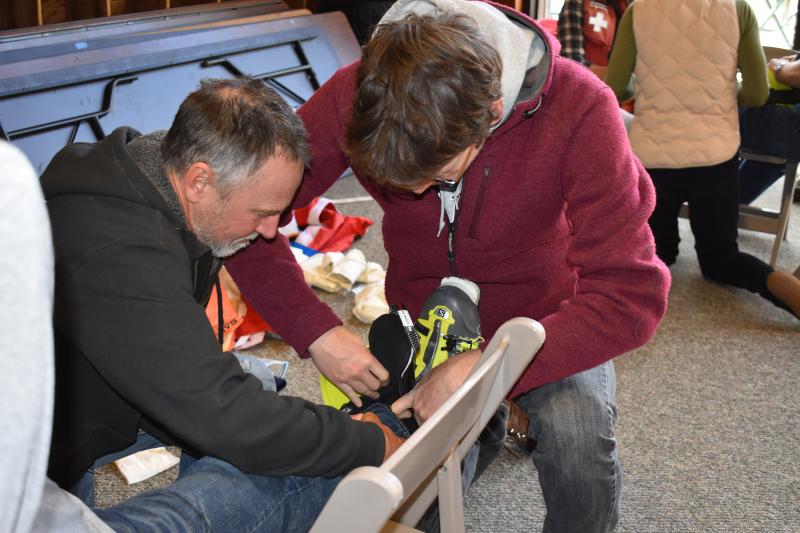 Taking a boot off an injured leg is a precise maneuver. Patrollers Rod Norberg and Dominic Dill get the boot ready to slide off the foot. (Photo courtesy Sarah Thompson)
Taking a boot off an injured leg is a precise maneuver. Patrollers Rod Norberg and Dominic Dill get the boot ready to slide off the foot. (Photo courtesy Sarah Thompson)
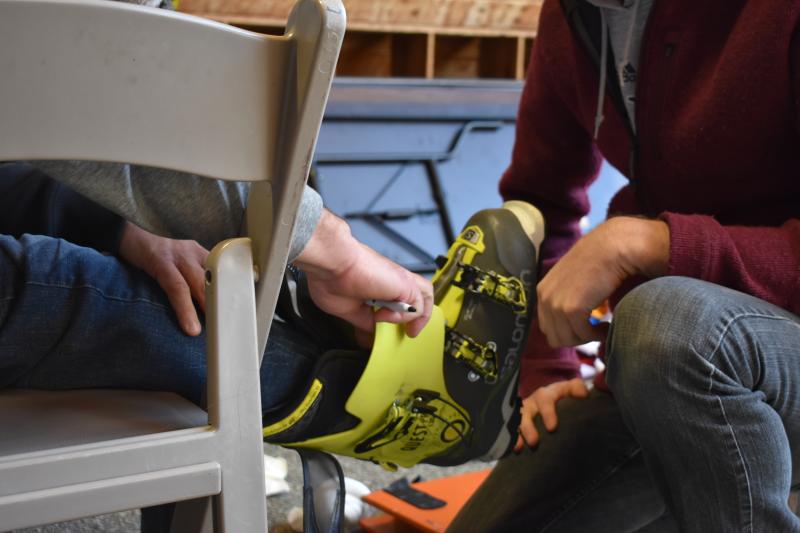 (Photo courtesy Sarah Thompson)
(Photo courtesy Sarah Thompson)
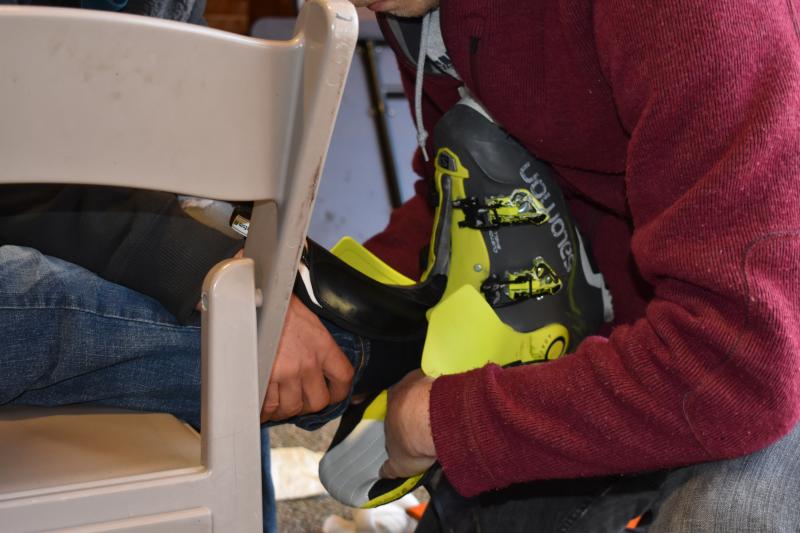 (Photo courtesy Sarah Thompson)
(Photo courtesy Sarah Thompson)
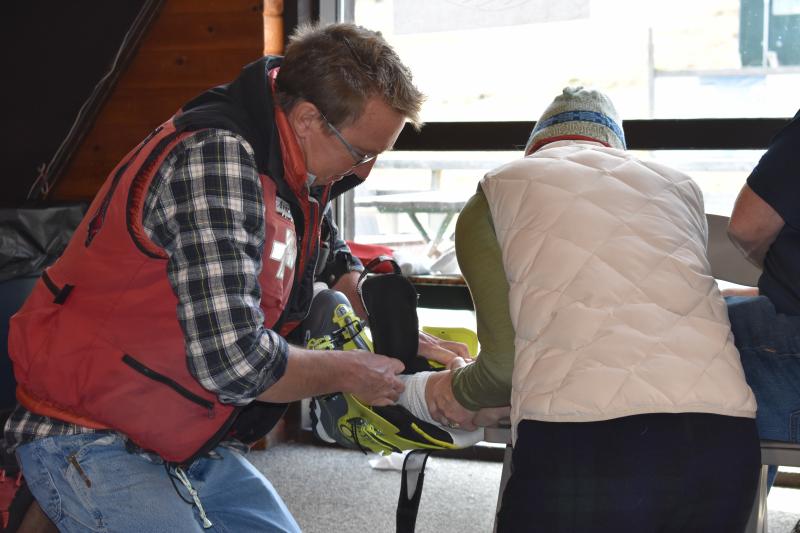 (Photo courtesy Sarah Thompson)
(Photo courtesy Sarah Thompson)
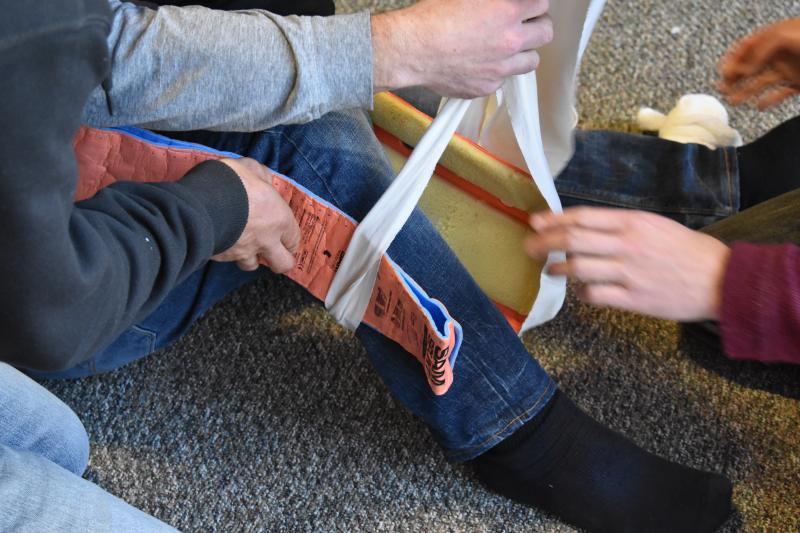 (Photo courtesy Sarah Thompson)
(Photo courtesy Sarah Thompson)
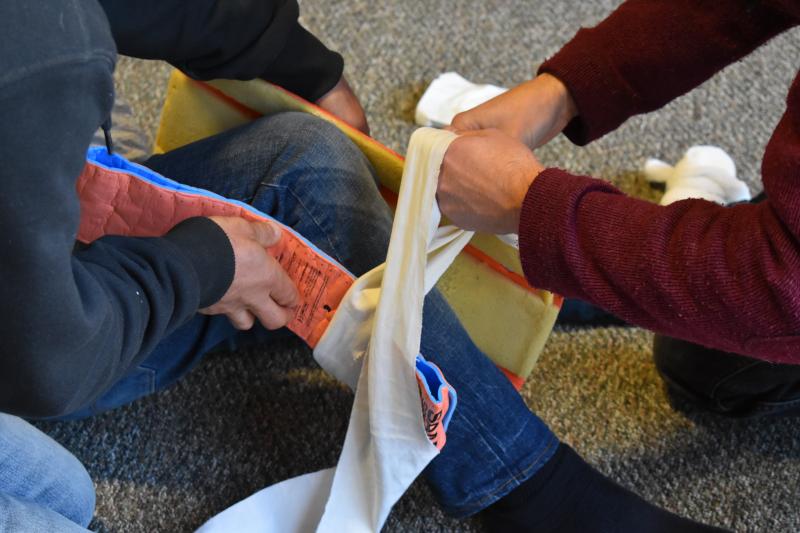 (Photo courtesy Sarah Thompson)
(Photo courtesy Sarah Thompson)
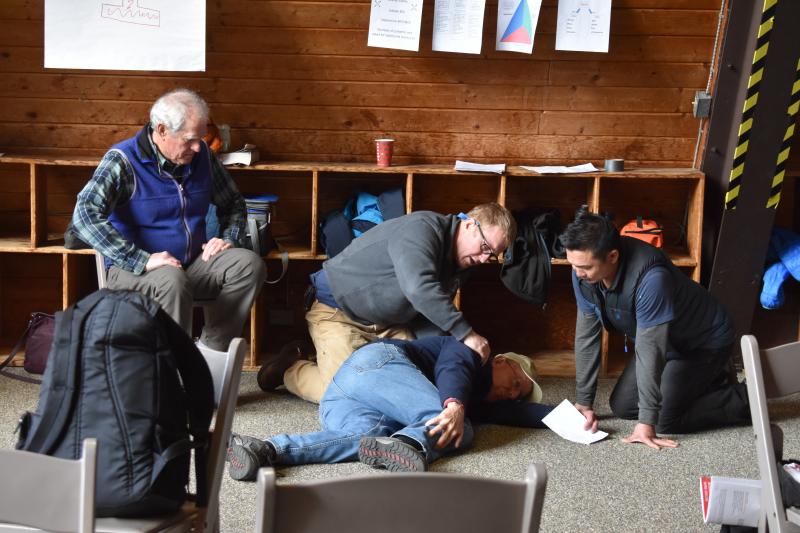 (Photo courtesy Sarah Thompson)
(Photo courtesy Sarah Thompson)
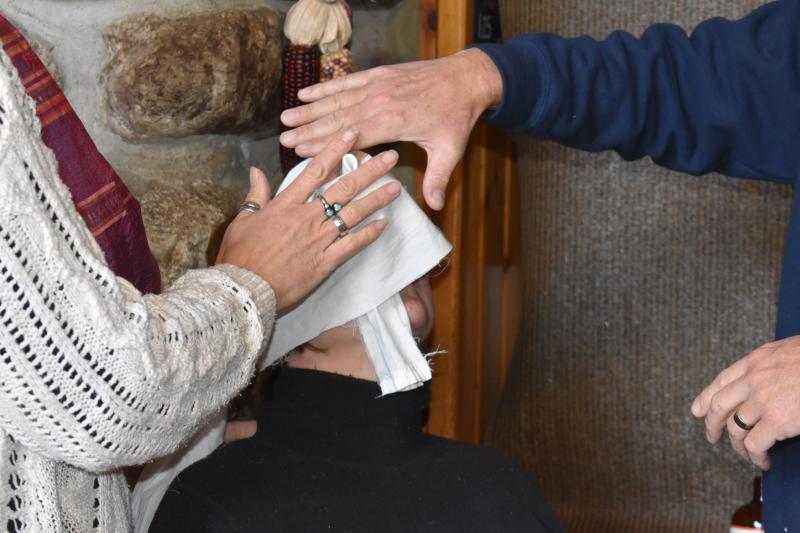 (Photo courtesy Sarah Thompson)
(Photo courtesy Sarah Thompson)
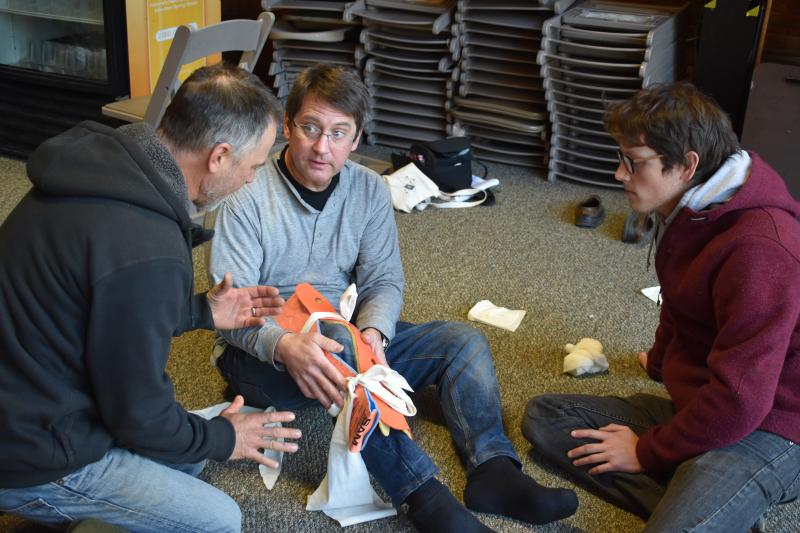 (Photo courtesy Sarah Thompson)
(Photo courtesy Sarah Thompson)
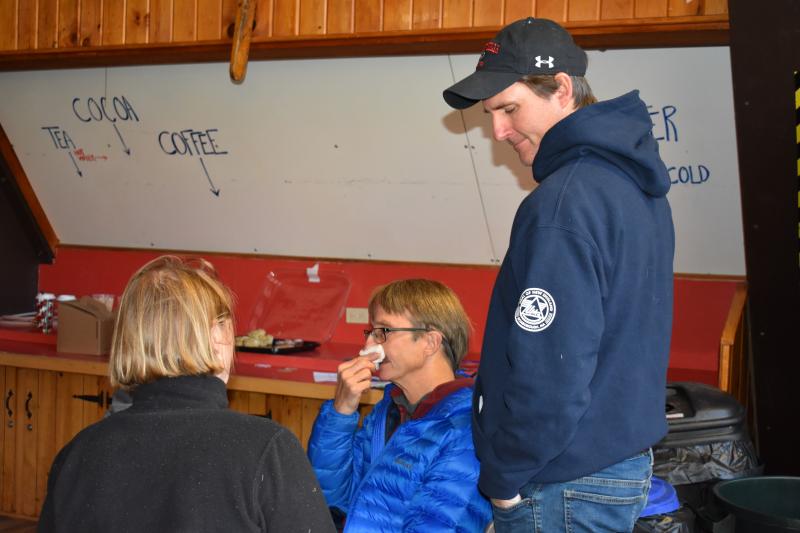 (Photo courtesy Sarah Thompson)
(Photo courtesy Sarah Thompson)
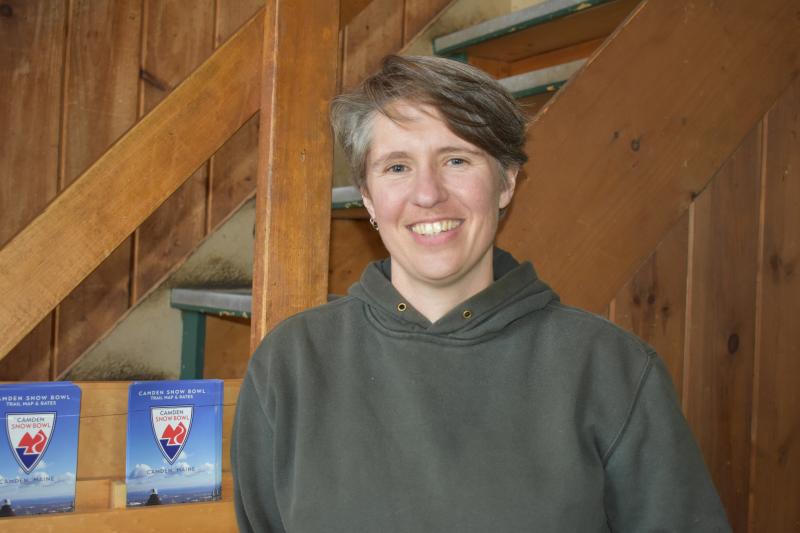 Meredith Currier, Camden Snow Bowl patrol training director. (Photo courtesy Sarah Thompson)
Meredith Currier, Camden Snow Bowl patrol training director. (Photo courtesy Sarah Thompson)
 Volunteer ski patrollers Deb Moskowitz, Dan Beardsley and Avery Brott practice working together to prepare a patient with a leg injury for transport down a ski trail. (Photo courtesy Sarah Thompson)
Volunteer ski patrollers Deb Moskowitz, Dan Beardsley and Avery Brott practice working together to prepare a patient with a leg injury for transport down a ski trail. (Photo courtesy Sarah Thompson)
 (Photo courtesy Sarah Thompson)
(Photo courtesy Sarah Thompson)
 (Photo courtesy Sarah Thompson)
(Photo courtesy Sarah Thompson)
 (Photo courtesy Sarah Thompson)
(Photo courtesy Sarah Thompson)
 Ragged Mountain Ski Patrol Director Duncan Matlack plays victim with a leg injury while patrollers Ken von Felten, Kevin Davis and Danielle Beardsley practice knee injury treatment. (Photo courtesy Sarah Thompson)
Ragged Mountain Ski Patrol Director Duncan Matlack plays victim with a leg injury while patrollers Ken von Felten, Kevin Davis and Danielle Beardsley practice knee injury treatment. (Photo courtesy Sarah Thompson)
 Patroller Lynda Clancy straps the splint onto the injured leg. (Photo courtesy Sarah Thompson)
Patroller Lynda Clancy straps the splint onto the injured leg. (Photo courtesy Sarah Thompson)
 Patroller Steve Hedsell, right, secures a splint to an injured leg. (Photo courtesy Sarah Thompson)
Patroller Steve Hedsell, right, secures a splint to an injured leg. (Photo courtesy Sarah Thompson)
 (Photo courtesy Sarah Thompson)
(Photo courtesy Sarah Thompson)
 Patroller Galen Todd briefs other patrollers on scene size up, patient assessment and procedures. (Photo courtesy Sarah Thompson)
Patroller Galen Todd briefs other patrollers on scene size up, patient assessment and procedures. (Photo courtesy Sarah Thompson)
 Patrollers Doug Woodbury and Tony Fitch tend to an eye injury that involves an eyeball punctured by a stick. (Photo courtesy Sarah Thompson)
Patrollers Doug Woodbury and Tony Fitch tend to an eye injury that involves an eyeball punctured by a stick. (Photo courtesy Sarah Thompson)
 Patrollers Bob Winslow and Stephanie Martin cope with eye injuries. (Photo courtesy Sarah Thompson)
Patrollers Bob Winslow and Stephanie Martin cope with eye injuries. (Photo courtesy Sarah Thompson)
 Patrollers Sandie Sabaka and Jada Beardsley checks vitals on patroller Alex Cohn. (Photo courtesy Sarah Thompson)
Patrollers Sandie Sabaka and Jada Beardsley checks vitals on patroller Alex Cohn. (Photo courtesy Sarah Thompson)
 A toboggan stands at the ready. (Photo courtesy Sarah Thompson)
A toboggan stands at the ready. (Photo courtesy Sarah Thompson)
 Jams and pretzels. Moving a patient without moving a suddenly misaligned joint. Patrollers Jeff Jones, Bob Winslow and Stephanie Martin work on fellow patroller victim Chuck Nguyen (Photo courtesy Sarah Thompson)
Jams and pretzels. Moving a patient without moving a suddenly misaligned joint. Patrollers Jeff Jones, Bob Winslow and Stephanie Martin work on fellow patroller victim Chuck Nguyen (Photo courtesy Sarah Thompson)
 .... And onto his back. (Photo courtesy Sarah Thompson)
.... And onto his back. (Photo courtesy Sarah Thompson)
 Patroller Morgan Laidlaw, age 7 in this scenario, fell on the trail. He cries and tells the patroller that his leg hurts. (Photo courtesy Sarah Thompson)
Patroller Morgan Laidlaw, age 7 in this scenario, fell on the trail. He cries and tells the patroller that his leg hurts. (Photo courtesy Sarah Thompson)
 Do you hurt anywhere else? How about here? (Photo courtesy Sarah Thompson)
Do you hurt anywhere else? How about here? (Photo courtesy Sarah Thompson)
 Superficial gash to patroller Brian Robinson’s nose. (Photo courtesy Sarah Thompson)
Superficial gash to patroller Brian Robinson’s nose. (Photo courtesy Sarah Thompson)
 (Photo courtesy Sarah Thompson)
(Photo courtesy Sarah Thompson)
 Patrollers Dominic Dill, Deb Moskowitz and Jada Beardsley get the tank ready to administer oxygen. (Photo courtesy Sarah Thompson)
Patrollers Dominic Dill, Deb Moskowitz and Jada Beardsley get the tank ready to administer oxygen. (Photo courtesy Sarah Thompson)
 (Photo courtesy Sarah Thompson)
(Photo courtesy Sarah Thompson)
 Patrollers Avery Brott, Rod Norberg and Ann Pietroski practice CPR on a victim. (Photo courtesy Sarah Thompson)
Patrollers Avery Brott, Rod Norberg and Ann Pietroski practice CPR on a victim. (Photo courtesy Sarah Thompson)
 (Photo courtesy Sarah Thompson)
(Photo courtesy Sarah Thompson)
 (Photo courtesy Sarah Thompson)
(Photo courtesy Sarah Thompson)
 Patroller Rod Norberg uses a pen light to determine pupil dilation. (Photo courtesy Sarah Thompson)
Patroller Rod Norberg uses a pen light to determine pupil dilation. (Photo courtesy Sarah Thompson)
 (Photo courtesy Sarah Thompson)
(Photo courtesy Sarah Thompson)
 (Photo courtesy Sarah Thompson)
(Photo courtesy Sarah Thompson)
 (Photo courtesy Sarah Thompson)
(Photo courtesy Sarah Thompson)
 (Photo courtesy Sarah Thompson)
(Photo courtesy Sarah Thompson)
 (Photo courtesy Sarah Thompson)
(Photo courtesy Sarah Thompson)
 (Photo courtesy Sarah Thompson)
(Photo courtesy Sarah Thompson)
 What to do if there is a gaping wound, exposing the lung. Patrollers Cathie Dorr, Michael Morse, Bob Winslow, Chuck Nguyen, Tony Fitch, Doug Woodbury and Jeff Jones talk it over.... (Photo courtesy Sarah Thompson)
What to do if there is a gaping wound, exposing the lung. Patrollers Cathie Dorr, Michael Morse, Bob Winslow, Chuck Nguyen, Tony Fitch, Doug Woodbury and Jeff Jones talk it over.... (Photo courtesy Sarah Thompson)
 .... and practice bandaging the body around a possible lung drainage tube (in this case, an eggplant). (Photo courtesy Sarah Thompson)
.... and practice bandaging the body around a possible lung drainage tube (in this case, an eggplant). (Photo courtesy Sarah Thompson)
 Patrollers Cathie Dorr and Jeff Jones seal up (on three sides) a gaping chest wound. (Photo courtesy Sarah Thompson)
Patrollers Cathie Dorr and Jeff Jones seal up (on three sides) a gaping chest wound. (Photo courtesy Sarah Thompson)
 What do wheezy lungs sound like? Patrollers Tony Fitch and Chuck Nguyen practice on Michael Morse. (Photo courtesy Sarah Thompson)
What do wheezy lungs sound like? Patrollers Tony Fitch and Chuck Nguyen practice on Michael Morse. (Photo courtesy Sarah Thompson)
 (Photo courtesy Sarah Thompson)
(Photo courtesy Sarah Thompson)
 Patrollers Sarah Ruef-Lindquist and Alex Cohn practice measuring a splint for a broken femur. (Photo courtesy Sarah Thompson)
Patrollers Sarah Ruef-Lindquist and Alex Cohn practice measuring a splint for a broken femur. (Photo courtesy Sarah Thompson)
 Patrollers Sarah Ruef-Lindquist and Alex Cohn practice measuring a splint for a broken femur. (Photo courtesy Sarah Thompson)
Patrollers Sarah Ruef-Lindquist and Alex Cohn practice measuring a splint for a broken femur. (Photo courtesy Sarah Thompson)
 Patrollers Lynda Clancy, Ken von Felten, Danielle Beardsley get patroller victim Brian Robinson out of his jams and pretzel position... (Photo courtesy Sarah Thompson)
Patrollers Lynda Clancy, Ken von Felten, Danielle Beardsley get patroller victim Brian Robinson out of his jams and pretzel position... (Photo courtesy Sarah Thompson)
 and roll him to a back board. (Photo courtesy Sarah Thompson)
and roll him to a back board. (Photo courtesy Sarah Thompson)
 Refresher workbook is a lot lighter than the initial course book. (Photo courtesy Sarah Thompson)
Refresher workbook is a lot lighter than the initial course book. (Photo courtesy Sarah Thompson)
 The initial course book. (Photo courtesy Sarah Thompson)
The initial course book. (Photo courtesy Sarah Thompson)
 (Photo courtesy Sarah Thompson)
(Photo courtesy Sarah Thompson)
 (Photo courtesy Sarah Thompson)
(Photo courtesy Sarah Thompson)
 Taking a boot off an injured leg is a precise maneuver. Patrollers Rod Norberg and Dominic Dill get the boot ready to slide off the foot. (Photo courtesy Sarah Thompson)
Taking a boot off an injured leg is a precise maneuver. Patrollers Rod Norberg and Dominic Dill get the boot ready to slide off the foot. (Photo courtesy Sarah Thompson)
 (Photo courtesy Sarah Thompson)
(Photo courtesy Sarah Thompson)
 (Photo courtesy Sarah Thompson)
(Photo courtesy Sarah Thompson)
 (Photo courtesy Sarah Thompson)
(Photo courtesy Sarah Thompson)
 (Photo courtesy Sarah Thompson)
(Photo courtesy Sarah Thompson)
 (Photo courtesy Sarah Thompson)
(Photo courtesy Sarah Thompson)
 (Photo courtesy Sarah Thompson)
(Photo courtesy Sarah Thompson)
 (Photo courtesy Sarah Thompson)
(Photo courtesy Sarah Thompson)
 (Photo courtesy Sarah Thompson)
(Photo courtesy Sarah Thompson)
 (Photo courtesy Sarah Thompson)
(Photo courtesy Sarah Thompson)
 Meredith Currier, Camden Snow Bowl patrol training director. (Photo courtesy Sarah Thompson)
Meredith Currier, Camden Snow Bowl patrol training director. (Photo courtesy Sarah Thompson)
CAMDEN — Gathering in the Snow Bowl lodge early Sunday morning, Nov. 17, approximately 40 volunteer Ragged Mountain ski patrollers refreshed their outdoor emergency care skills in intense preseason training.
In July, online modules, created by the National Ski Patrol, hit the mailboxes. From then on, a Midcoast snow-loving lobsterman, architect, banker, nurse, boy scout leader, and more, have been knee-deep in medical terminology, chest compressions, signs and symptoms of shock and trauma, how to package and transport the injured down the mountain, and checking supplies in the back packs they are never without.
For more than five hours, scenarios played forth in the lodge, with bandages, gauze, and skewed eye glasses parlaying with the dramatized lung collapse, jammed joint, diabetic emergency, sobbing and broken-legged child, and unsympathetic parent.
The “stations,” as set up by the more seasoned patrollers the night before, were real-life situations that could be encountered on any ski mountain, including the Camden Snow Bowl.
The patrollers are as varied in careers as their personalities, but they have one thing in common: They love the Snow Bowl, they love to ski, and they care about public safety. Their personal experiences range from background educations in physics, child care, finance and banks, teachers, nurses, fishermen and farmers.
They all completed the required and rigorous 100-hour outdoor emergency care (OEC) course, and have earned certifications in ski and toboggan management.
From ski trail to patrol room
With injured skiers and snowboarders, care starts as soon as a patroller arrives on scene. Take a “tib fib boot top fractures” (a broken leg between the knee and boot top). On the hill, the leg will be wrapped, immobilized, and depending on other injuries, including spinal, the patient may be collared and back-boarded. All the while, assessments are verbalized via radio to “patrol summit,” starting at the geographical site where the accident occurred.
Do the pupils dilate? Are the lungs inflating? Can the leg straighten? Should a backboard and neck collar be required? Where’s the pulse? Does the patient remember his name? Does the patroller need an oxygen tank. An AED?
Other patrollers are at the ready to respond with equipment and manpower.
Each patroller carries a patrol pack with required gear, including gauze, bandaids, trauma sheers, tourniquets, space blankets, and much more. Larger toboggan packs are towed behind. Those include backboards, equipment for putting a patient on a backboard, large splints and blankets.
And if a patient needs to be transported in one of those toboggans?
Gear is rearranged, the injured strapped in, and transported down to the patrol room in the lodge basement.
“By the time we are done with all of that – the combination of our packs and the toboggan – we carry something quite similar to what a basic EMT would have,” said Meredith Currier, a longtime patroller, training director for the Snow Bowl, and who is involved in statewide patrol instruction. “The investment of the patrol and the patrollers in keeping all of that gear working is significant.”
Ski patrol outdoor emergency care training is equivalent to that of an Emergency Medical Technician (EMT). They do not administer medications beyond glucose.
Beyond that, though, ski patrollers can expect to encounter a full gamut of ailments and concerns.
So, too, is the time and financial investments of Camden’s volunteer patrollers. Each is provided an official patrol jacket by the Snow Bowl. The helmet, boots, skis, training, and patrol packs are individual responsibilities.
A small portion of a skier’s lift ticket enters the Patrol budget to purchase supplies — bandages, splints, oxygen and other vital lifesaving equipment.
The Snow Bowl is generous to volunteers based on certain levels of commitment, according to Currier. A certain number of volunteer patrol hours generates a free individual ski pass. A higher level of hours can generate a free family pass.
Yet, the majority of funding for the 501c3 ski patrol department comes from fundraising.
“It’s a labor of love,” said Currier.
Good timing
Just prior to the 2008 ski season, the Ragged Mountain Ski Patrol agreed to incorporate an incident command system, which is now an integral part of all ski mountains, and first responder protocol across the country. Patrollers, like first responders everywhere, take an online course required by the Federal Emergency Management Agency. The Incident Command System according to FEMA, “is a management system designed to enable effective and efficient domestic incident management by integrating a combination of facilities, equipment, personnel, procedures, and communications operating within a common organizational structure.”
That means that if a crisis occurs, the local responding firefighters, police, ambulance, ski patrol and other trained entities can more effectively work together.
Within weeks after formally putting operational management procedures in place, the Snow Bowl’s toboggan chute underwent a mass casualty, when multiple individuals were injured at the same time.
Meredith Currier happened to be on patrol that day, when eight people – toboggan riders and bystanders — suffered injuries in a collision during the 2008 Toboggan Nationals.
Some of those people immediately returned to their feet with minor injuries, according to Currier. Others were severely hurt, with one helovac-ed out by LifeFlight of Maine.
“In terms of patient treatment in medicine, that hasn’t really changed for us,” said Meredith Currier. “But, how to manage a situation like that, there were some big learnings there, which have really helped us.”
In 2008, patroller Galen Todd had that recent incident command training fresh in his mind. He jumped to action, establishing eight triage sites to manage a densely populated spot, where a lively crowd had gathered to watch the toboggans speed down the chute.
Immediate help arrived with licensed medical personnel, who happened to be at the mountain that day, and Todd delegated stations.
Every ambulance in the region descended on the Snow Bowl, recollected Todd, during the November 2019 training session. The roads were jammed, and the only reachable landing zone was a hilltop cemetery, which the Snow Bowl quickly plowed for the LifeFlight helicopter.
As patients were loaded and transported to hospitals, ski patrollers went back to their assigned duties.
One skier, blissfully unaware of what had recently happened, caught up with Todd.
“That was the smoothest training session I’ve ever seen,” the skier said.
Event Date
Address
United States


































































































































